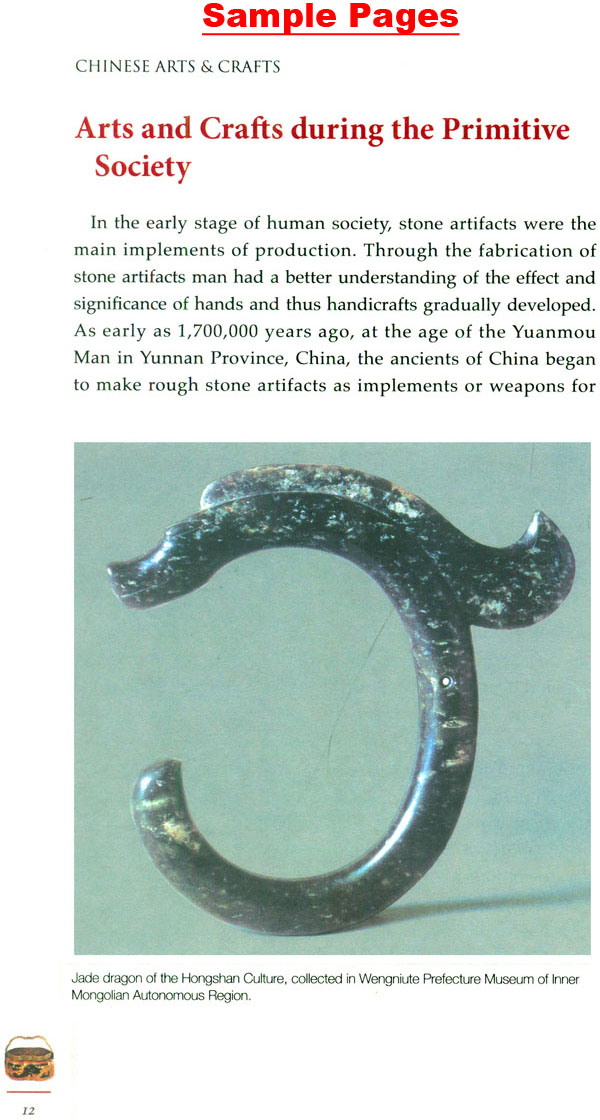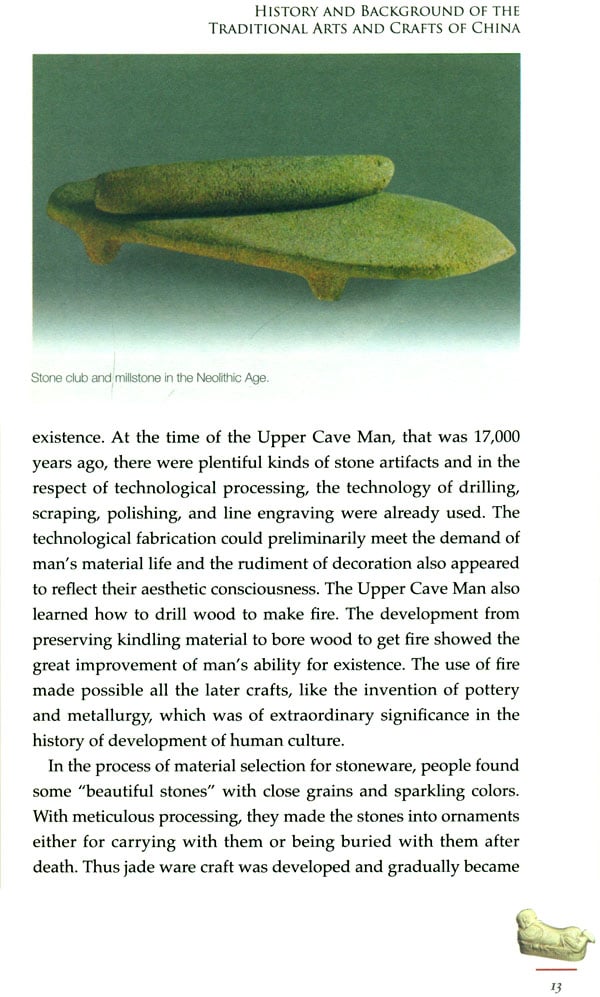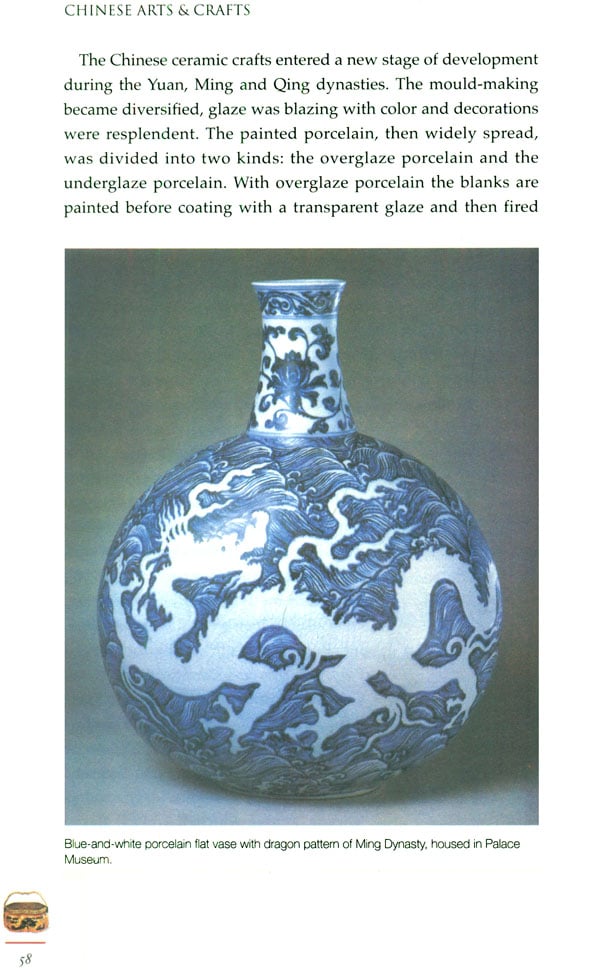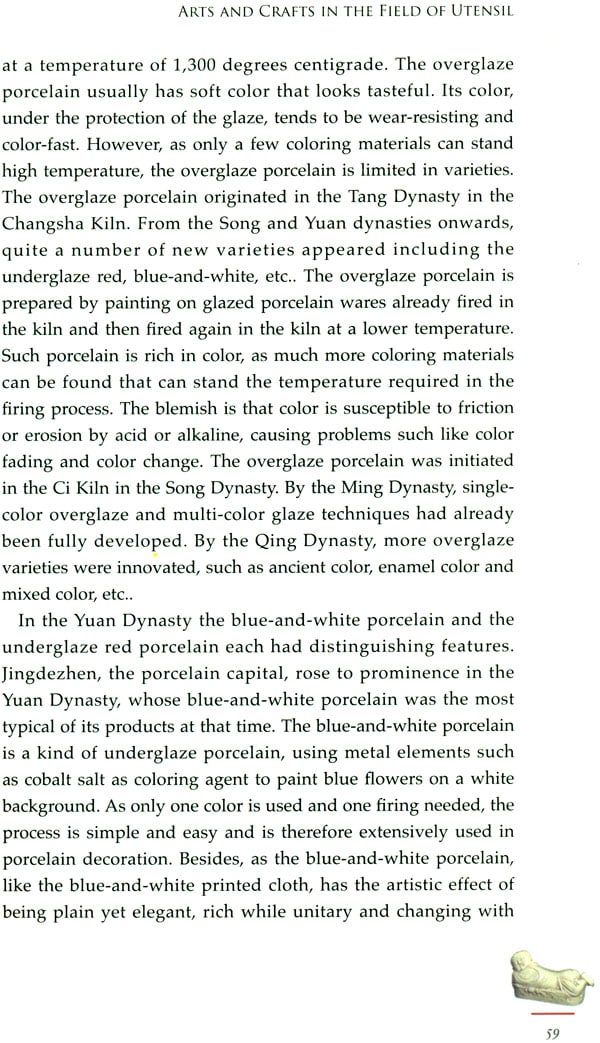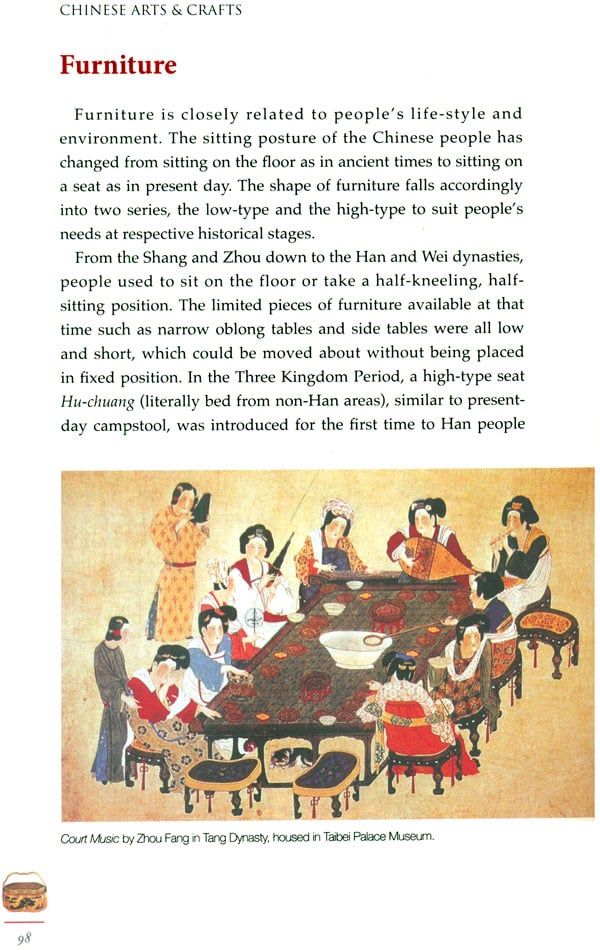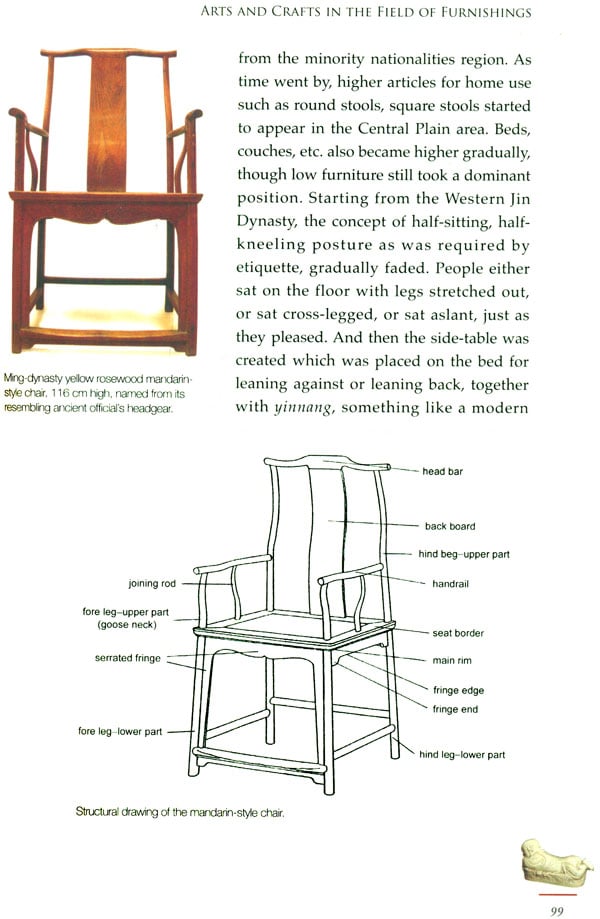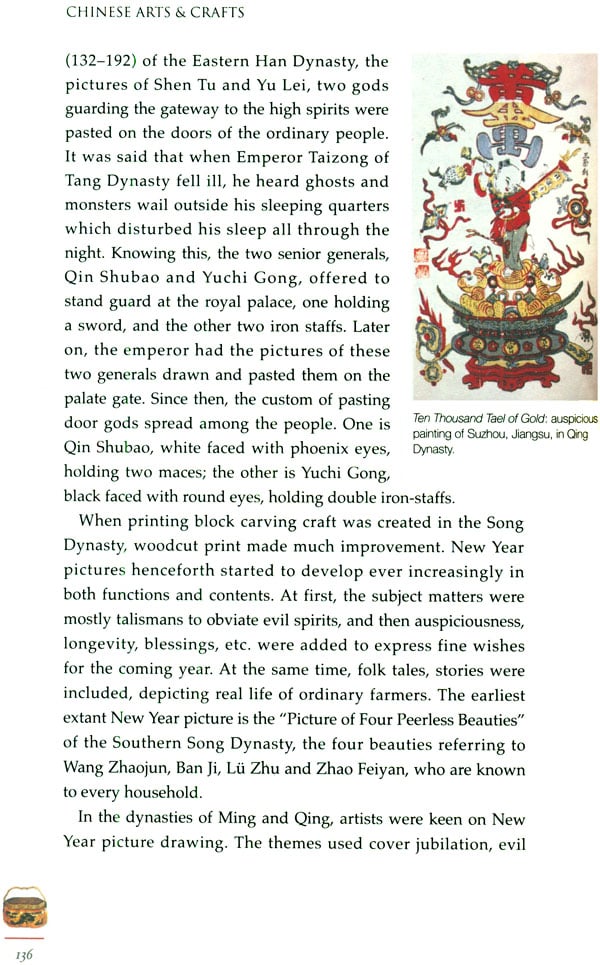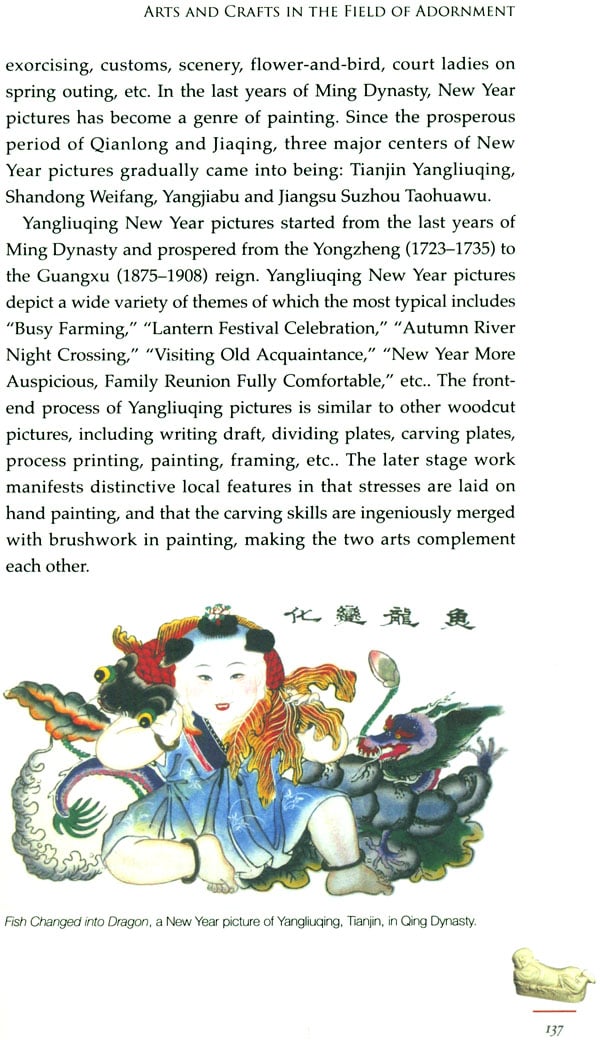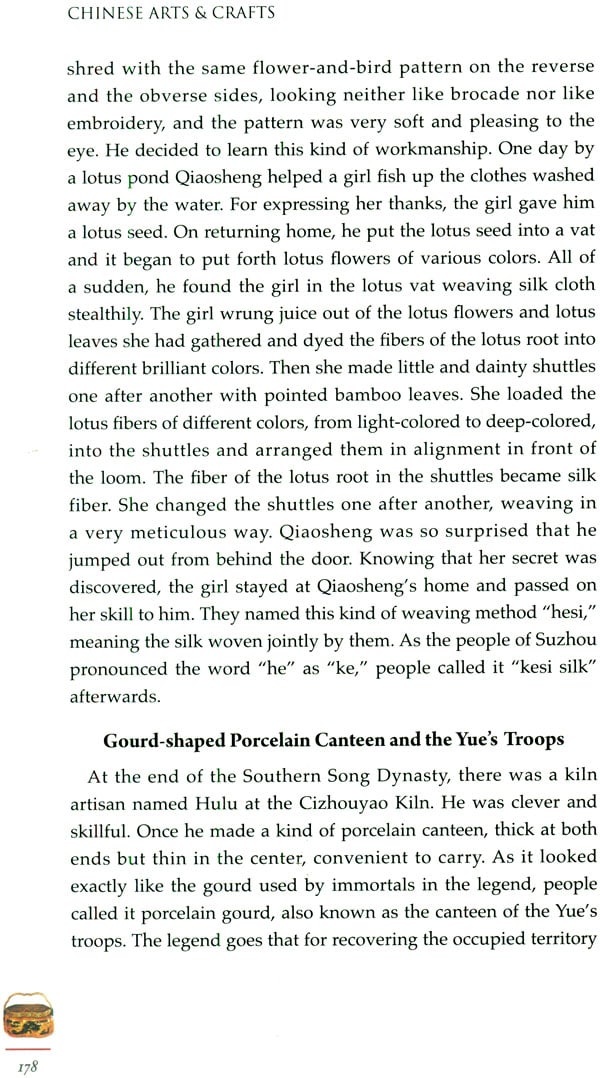
Chinese Arts and Crafts (History, Techniques and Legends)
Book Specification
| Item Code: | NAN204 |
| Author: | Hang Jian & Guo Qiuhui |
| Publisher: | China International Press |
| Language: | English |
| Edition: | 2010 |
| ISBN: | 9787508516080 |
| Pages: | 208 (Throughout B/W & Color Illustrations) |
| Cover: | Paperback |
| Other Details | 9.0 inch X 6.0 inch |
| Weight | 340 gm |
Book Description
The heaven has time, the earth has vitality, material has beauty, work has ingenuity. Chinese arts and crafts enjoy a unique reputation in the history of material civilization among various nations in the world. For several thousands of years, people’s handicrafts in their development echoed with the rhythm of life-working with the rising sun and reposing at sunset. All species of handicrafts in their earliest states are related to usage: always practical, plain and warm, and in possession of a wisdom that adapts to agricultural civilization. Even the high-end handicrafts at the court and among the literati, such unpretentious tradition still remain and reveal a touch of pragmatic trace. All this is associated with the everlasting farming culture of China and her exceptional geographical position, which has left us rich cultural heritage in which wisdom of life and human creation is contained.
Hang Jian, born 1961, Ph. D., professor with Academy of Arts and Design, Tsinghua University, deputy dean. Graduated from Department of Art History, Central Academy of Arts, he was once editor-in-chief of the Decoration Journal; director of Department of Art History, Academy of Arts and Design, Tsinghua University; managing deputy director of Cheung Kong School of Arts and Design, Shantou University; senior visiting scholar to College of Architecture, Art, and Planning, Cornell University, USA. His writings include Yuanxiang. Design, Way of Design Basic Problems in Chinese Design, A History of Chinese Technology Aesthetics, The Idea of Craftsmanship, New Figural Art, Art Dimensions, Wisdom of the Body Spiritual Landscape of Contemporary Chinese Oil Paintings, A History of Chinese Technology Aesthetic Ideology, etc.
Guo Qiuhui, born 1979, Doctor of Design Art, graduated from Department of Art History currently postdoctoral researcher with Academy of Arts and Design, Tsinghua University. Writings include Chinese Arts and Crafts (written jointly), Chasing the Sun’s Light and Reflection. Deng Wei (compiled jointly).
The traditional arts and crafts of China have won unique good reputations in the history of the material culture of the various nationalities in the world. Since Zhang Qian (?-c.114 B.C.) of the Han Dynasty served as an envoy abroad to the Western Regions (a Han Dynasty term for the area west of Yumenguan, including what is now Xinjiang and parts of Central Asia) and the gradual formation of the Silk Route, the traditional arts and crafts of China have been introduced in an unfailing way to the Middle East first via the Central Asia and the Western Asia and then to Europe and the five continents and four oceans. At the time when other nationalities intruded or disorders caused by continuous military operations, Chinese craftsmen in the successive dynasties of past ages could often survive by virtue of one single skill and became emissaries for diffusing the culture of different nationalities. In the traditional Chinese philosophy, Chinese ancient thinkers started, as early as in the first century, to use handicraft skills to compare to and interpret various kinds of considerations in the ways of running a state or looking at life.
All this is related to the unique geographic location of China and its farming culture that was formed continuously for a very long time.
The mainland of China possesses a long coastline but its source of civilization, the Central Plains (comprising the middle and lower reaches of the Yellow River), goes deep into the inland. The three earliest systems of state power in China, the Xia Dynasty, the Shang Dynasty and the Western Zhou Dynasty, all emerged in the inland. For the nationalities that grew up on plains and in mountain areas, cultivation and irrigation of land were the most important ways of existence. As a result, the astronomical calendar, the fabrication of farming tools, and the ethical concept of how to get along well with others all developed on such a premise. It was this kind of life and the style of art in the agricultural farming society that decided the special features of the traditional arts and crafts of China. Its workmanship surrounded the practice of tilling the farm by men and spinning and weaving by women as well as the way of starting to work at sunrise and to rest at sunset. The initial state of all articles and utensils was closely related to the purpose of different uses. They should be convenient and simple for use, having the wisdom of fitting in with agricultural civilization. Even at its top-level, i.e. the arts and crafts for court use and those for scholars, the vestiges of practical use and tradition of simplicity were still maintained. Its decorative style was natural. Within the vision of natural economy, hills and waters, animals and plants were the main patterns and ornaments. Absurd or ferocious decorations were scarcely seen. Instead they were full of optimistic spirit and progress making.
The Chinese traditional ethics has an argument “Riding a hobby saps one’s will to make progress,” which was used to oppose” diabolic tricks and wicked craft” so as to hold in check excessive development of skills that had no practical value. The influence of this idea has made the arts and crafts of China develop along the orientation of functionalism for thousands of years without having made waste to the society but having made workmanship develop to the extreme in the farming society instead. Nevertheless, it has also brought about certain conservation as when skills reach certain level, they will cause certain check and hesitation to the advance of social and scientific progress.
On the whole, the tradition of Chinese arts and crafts, however, is worth praising. It has left us abundant cultural heritage, including a lot of man-made articles and wisdom of life.
The wisdom implied in the traditional arts and crafts of China can be summed up in the following six aspects:
The first aspect is “to value life and to use objects.” It means emphasis should be laid on man’s life, all man-made objects should be under control and for all skills the first priority should be given to human beings. This is what we call “people-oriented” today. This aspect is of great importance to the development of the traditional arts and crafts of China. Maybe someone will say that there is nothing strange for this idea as arts and crafts are for people’s use and man must be regarded as the main body. Yet such a simple issue like this once had a history with many twists and turns in Europe. After the Industrial Revolution in Britain, as the batch production with machines lowered the production cost and brought about the cheapest products, many people spoke highly of machine production and cheered for the achievements of the Industrial Revolution. However, before long when people found the products turned out by machines were all exactly the same, poorly and hastily manufactured, they began to be discontented with machine-made products, thinking that they denied man’s individuality and that it was a compulsory way of life for all people to use the same articles roughly made. On the other hand, to the producers of the batch production in the entire large industrial society, the division of labor along the assembly line was very elaborate and human beings became only a part of the machines. During the whole process of work, there was not any slightest delight worth mentioning. It was not like the traditional manual labor which could give you a feeling of closeness to the natural materials, touching them with your fingers and thinking of them while you were making. When working in the rhythm of agricultural economy, people had a kind of natural delight to work in the country. That was why William Morris (1834-1896), a utopian socialist and idealist in design appeared in Europe in the 19th century.
At the very beginning, the traditional Chinese arts and crafts gave full considerations to the factor of human beings in making articles for use. Mechanical production in China also already reached a fairly high level in the early stage, particularly at the rudimental stage of capitalism at the end of the Ming Dynasty. At the then Shengze Town of Songjiang (under the jurisdiction of Wujiang of Jiangsu Province today), cotton-weaving industry was already rather developed. Quite a few households had five to ten hand looms and even employed workers to operate them. There was also a clear division of labor between production processes. Nonetheless, this kind of production mode close to capitalist large industry did not develop from quantitative to qualitative change. The seeds of capitalism at the end of the Ming Dynasty, from beginning to end, did not greatly raise the volume of production and make maximum surplus value so that it could be input for extended reproduction and cause revolutionary changes in textile industry just like the Industrial Revolution in Britain through the reform of power in textile industry. Those cotton-weaving proprietors interrelating in innumerable ways with agriculture in the Ming Dynasty input the money they earned from cotton-weaving industry either into agricultural production again or into family construction such as to build houses, to buy land, to take concubine and bear children. Of course, it contains on the one hand the backward side of agricultural economy but on the other hand it also reflects that the feudal society of China laid emphasis on people’s life instead of developing mechanical production to extremes. This is closely related to the ancient idea of China to value life, to make man-made things under control, and to give the first importance to human beings in arts and crafts.
The second aspect is “to attain practical use and to benefit man.” It lays emphasis on utility and people’s livelihood. During the Qianlong Reign (1736-1795) of the Qing Dynasty when Western missionaries or diplomatic envoys of various countries came to China, most of the presents they presented to the emperor were playthings, such as chime clocks with robots. It shows that not all the things manufactured in the West at that time were not for practical use or people’s livelihood. On the contrary, the objects manufactured in ancient China always laid stress on functional uses. Guan Zhong (725-645 B.C.), a thinker in the Spring and Autumn Period, said something to the effect that wise craftsmen in the ancient time always followed the rule of not wasting their wisdom to make playthings of no use to people. Mo-tzu (c. 468-376 B.C.), a thinker in the Warring States Period, also raised a viewpoint of “doing what is beneficial to people and not doing what is not beneficial to people.” Today their views seem very simple but at their time were of great significance. So we can see the Chinese saying of “diabolic tricks and wicked craft” did not become the main trend in the feudal society of China lasting for a few thousand years, from beginning to end. The main trend of the traditional Chinese handicrafts was only the production of those things laying emphasis on practical use, closely related to national economy and people’s livelihood, and maintaining humane concerns.
CONTENTS
| Preface | 1 | |
| I | History and Background of the Traditional Arts and Crafts of China | 2 |
| Arts and Crafts during the Primitive Society | 12 | |
| Arts and Crafts during the Xia, Shang and Zhou Dynasties | 15 | |
| Arts and Crafts during the Spring and Autumn Period and the Warring States Period | 18 | |
| Arts and Crafts during the Qin and Han Dynasties | 22 | |
| Arts and Crafts during the Six Dynasties | 26 | |
| Arts and Crafts during the Sui, Tang and Five Dynasties | 31 | |
| Arts and Crafts during the Song, Liao, Jin and Yuan Dynasties | 35 | |
| Arts and Crafts during the Ming-Qing Dynasties and Republic of China | 41 | |
| II | Arts and Crafts in the Field of Utensil | 53 |
| Ceramics | 54 | |
| Bronze Ware | 62 | |
| Lacquer | 71 | |
| III | Arts and Crafts in the Field of Appareler | 77 |
| Embroidery | 78 | |
| Printing and Dyeing | 85 | |
| Silk Weaving | 89 | |
| IV | Arts and Crafts in the Field of Furnishings | 97 |
| Furniture | 98 | |
| Gold and Silver Ware, Glassware, Enamelware | 105 | |
| Bamboo Carving, Wood Carving, Ivory Carving | 114 | |
| V | Arts and Crafts in the Field of Adornment | 123 |
| Jade Artwork | 124 | |
| Paper-cut | 129 | |
| New Year Picture | 134 | |
| VI | Arts and Crafts in the Field of Entertainment | 139 |
| Toy | 140 | |
| Kite | 144 | |
| Puppet | 149 | |
| Silhouette | 154 | |
| VII | Arts and Crafts in the Field of Commerce | 159 |
| Shop Sign | 160 | |
| Packaging | 163 | |
| VIII | Legends concerning Traditional Arts and Crafts of China | 169 |
| IX | The Transition and Development of Traditional Chinese Arts and Crafts at the Present Age | 189 |
| Appendix: Chronological Table of the Chinese Dynasties | 204 |
